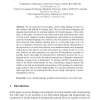Free Online Productivity Tools
i2Speak
i2Symbol
i2OCR
iTex2Img
iWeb2Print
iWeb2Shot
i2Type
iPdf2Split
iPdf2Merge
i2Bopomofo
i2Arabic
i2Style
i2Image
i2PDF
iLatex2Rtf
Sci2ools
DIAGRAMS
2008
Springer
2008
Springer
Graphical Revelations: Comparing Students' Translation Errors in Graphics and Logic
We are interested in developing a better understanding of what it is that students find difficult in learning logic. We use both natural language and diagram-based methods for teaching students the formal language of first-order logic. In this paper, we present some initial results that demonstrate that, when we look at how students construct diagrammatic representations of information expressed in natural language (NL) sentences, the error patterns are different from those observed when students translate from NL to first-order logic (FOL). In the NL-to-diagram construction task, errors associated with the interpretation of the expression not a small dodecahedron were manifested much more frequently with respect to the object's size than with respect to its shape. In the NL-to-FOL task, however, no such asymmetry was observed. We hypothesize a number of possible factors that might be implicated here: differences between the NL-todiagram and NL-to-FOL tasks; the reduced expressivi...
| Added | 19 Oct 2010 |
| Updated | 19 Oct 2010 |
| Type | Conference |
| Year | 2008 |
| Where | DIAGRAMS |
| Authors | Richard Cox, Robert Dale, John Etchemendy, Dave Barker-Plummer |
Comments (0)

